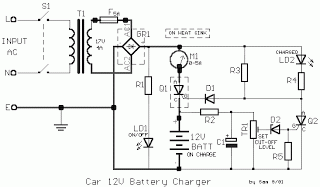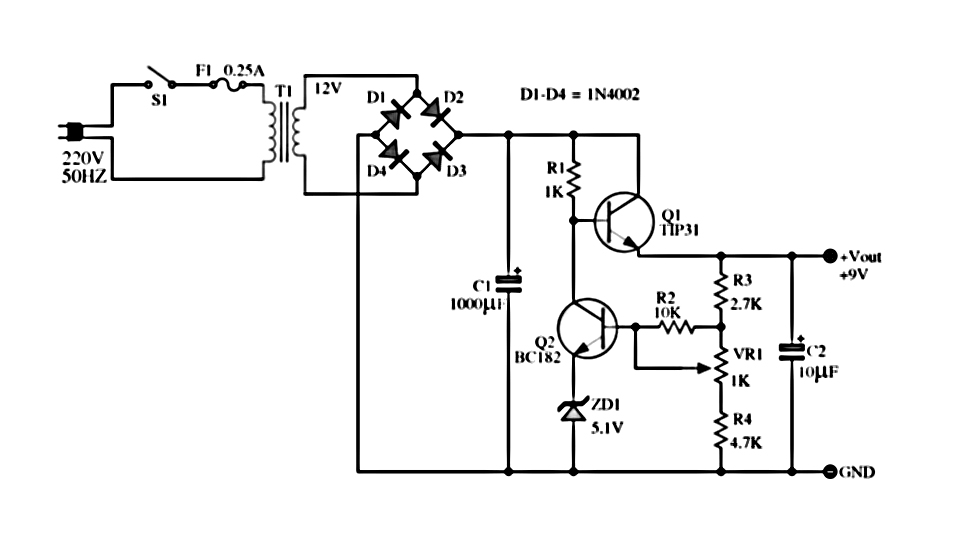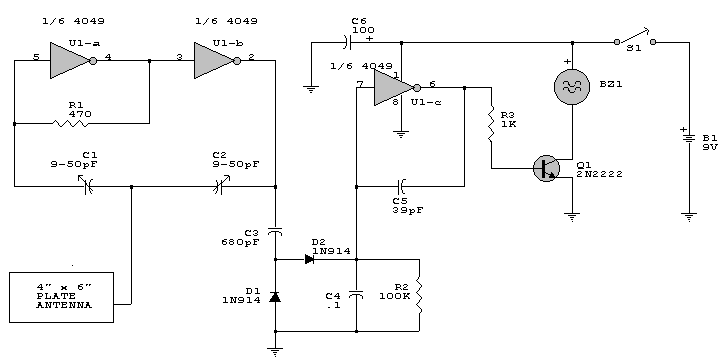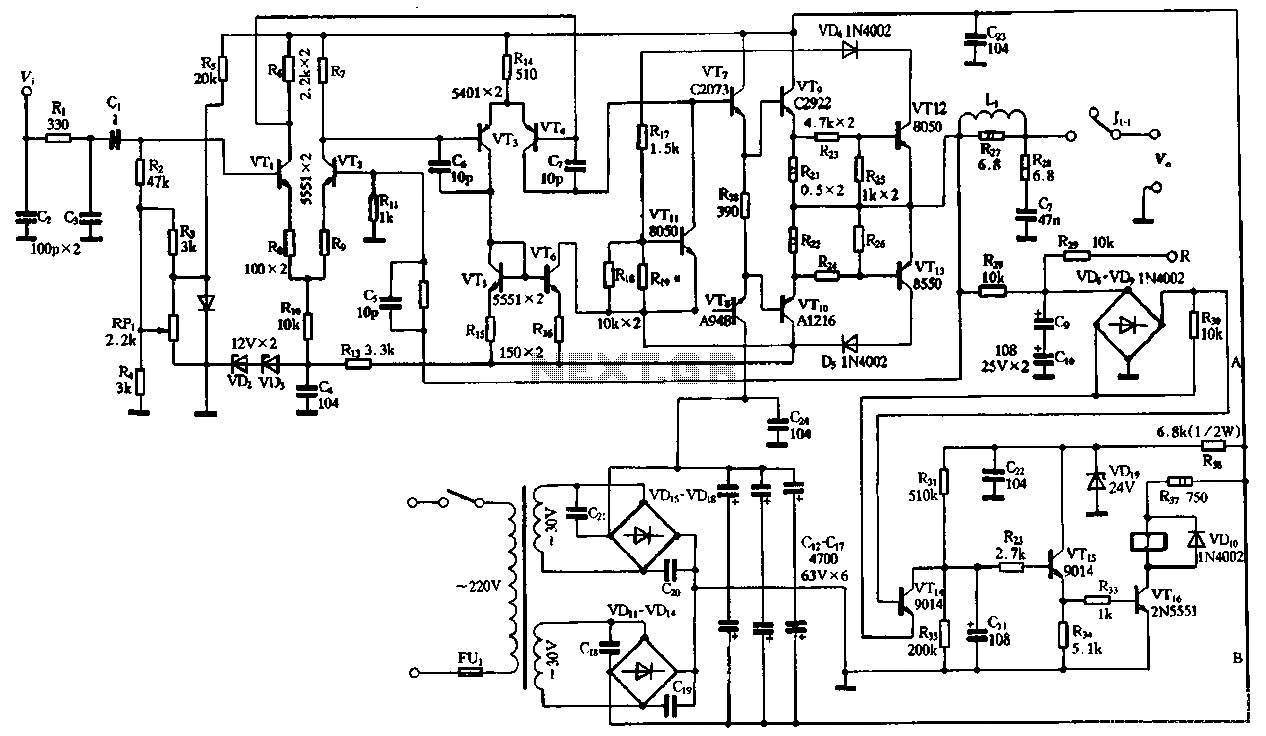
led vu meter circuit using lm3915 ic

This LED VU Meter (volume unit) is designed to monitor and display power levels present at the speaker terminals of a stereo audio power amplifier. The levels are represented in ten discrete steps using ten LEDs for each channel, providing an approximate visual indication of the audio power output for each channel. The circuit includes two external resistors (R2 and R3) that set the full scale between 1.2V and 12V applied to pin 5, with 5V used to illuminate all ten LEDs. The voltage necessary to activate all the LEDs is determined by R2 and R3. The integrated circuit generates a nominal 1.25V reference voltage (Vref) across pins 7 and 8, resulting in a constant current through R3, which also flows through R2. The total voltage across R2 and R3 is determined by this configuration. Internally, the chip contains ten voltage comparators, with the non-inverting (+) inputs connected to a precise ten-step voltage divider network. Each comparator triggers at a different comparison level, while the inverting (-) inputs are connected together and linked to an incoming DC signal through a high-impedance input buffer.
The LED VU Meter circuit operates by utilizing a combination of resistive voltage dividers and voltage comparators to create a visual representation of audio power levels. The primary function of the external resistors R2 and R3 is to establish the reference voltage range for the LED indicators. By adjusting these resistors, the user can calibrate the meter to respond to different input voltage levels, thereby allowing for flexibility in various audio applications.
The integrated circuit's internal architecture is crucial for its performance. The ten comparators are designed to compare the incoming audio signal against predefined voltage thresholds set by the voltage divider. As the audio signal fluctuates, the comparators activate corresponding LEDs based on the signal's amplitude. This results in a dynamic visual display that reflects the audio output in real time.
The high-impedance input buffer is essential for ensuring that the audio signal is not loaded down by the circuit, preserving the integrity of the input signal. This design choice allows the VU Meter to function effectively with a wide range of audio sources, from low-level signals to higher power outputs.
In summary, the LED VU Meter is an effective tool for visualizing audio power levels in stereo amplifiers. Its design incorporates a precise reference voltage, adjustable scaling resistors, and a robust comparator network, making it a versatile solution for audio monitoring applications.This LED VU Meter (volume-unit) is capable of monitoring and displaying power levels present at the speaker terminals of an stereo audio power amplifier. The levels are displayed in ten discrete steps using 10 LEDs for each channel. This project is designed to give an approximate visual indication of the audio power output of each channel.
This is the figure of the circuit; Two external resistors (R2 & R3) programs the full scale from between 1. 2V and 12V applied to pin 5. 10. 5V is used to turn on all 10 LED`s. The voltage required to turn on all the LEDs is set by R2 and R3. The IC develops a nominal 1. 25V reference voltage (Vref) across pins 7 and 8. Since this voltage is constant then the current through R3 is also constant. This current also flows through R2. The total voltage across R2 and R3 is given by voltage. Internally this chip consists of ten voltage comparators. The non-inverting (+) input of each comparator is connected to an accurate ten-step voltage divider network. Each comparator will therefore trigger on a different comparison level. The inverting (-) inputs of each comparator are commoned together and connected to an incoming DC signal via a high impedance input buffer.
🔗 External reference
The LED VU Meter circuit operates by utilizing a combination of resistive voltage dividers and voltage comparators to create a visual representation of audio power levels. The primary function of the external resistors R2 and R3 is to establish the reference voltage range for the LED indicators. By adjusting these resistors, the user can calibrate the meter to respond to different input voltage levels, thereby allowing for flexibility in various audio applications.
The integrated circuit's internal architecture is crucial for its performance. The ten comparators are designed to compare the incoming audio signal against predefined voltage thresholds set by the voltage divider. As the audio signal fluctuates, the comparators activate corresponding LEDs based on the signal's amplitude. This results in a dynamic visual display that reflects the audio output in real time.
The high-impedance input buffer is essential for ensuring that the audio signal is not loaded down by the circuit, preserving the integrity of the input signal. This design choice allows the VU Meter to function effectively with a wide range of audio sources, from low-level signals to higher power outputs.
In summary, the LED VU Meter is an effective tool for visualizing audio power levels in stereo amplifiers. Its design incorporates a precise reference voltage, adjustable scaling resistors, and a robust comparator network, making it a versatile solution for audio monitoring applications.This LED VU Meter (volume-unit) is capable of monitoring and displaying power levels present at the speaker terminals of an stereo audio power amplifier. The levels are displayed in ten discrete steps using 10 LEDs for each channel. This project is designed to give an approximate visual indication of the audio power output of each channel.
This is the figure of the circuit; Two external resistors (R2 & R3) programs the full scale from between 1. 2V and 12V applied to pin 5. 10. 5V is used to turn on all 10 LED`s. The voltage required to turn on all the LEDs is set by R2 and R3. The IC develops a nominal 1. 25V reference voltage (Vref) across pins 7 and 8. Since this voltage is constant then the current through R3 is also constant. This current also flows through R2. The total voltage across R2 and R3 is given by voltage. Internally this chip consists of ten voltage comparators. The non-inverting (+) input of each comparator is connected to an accurate ten-step voltage divider network. Each comparator will therefore trigger on a different comparison level. The inverting (-) inputs of each comparator are commoned together and connected to an incoming DC signal via a high impedance input buffer.
🔗 External reference





